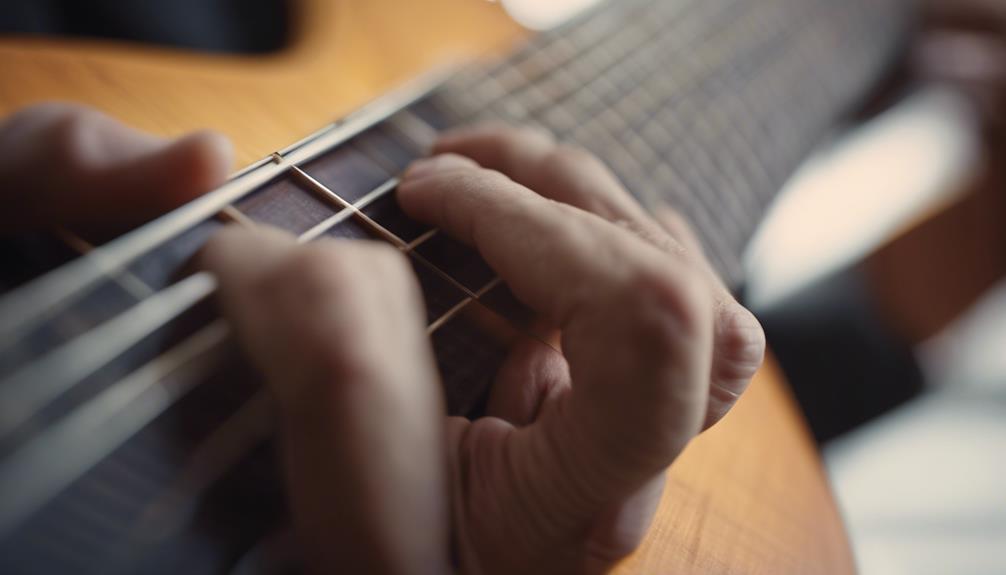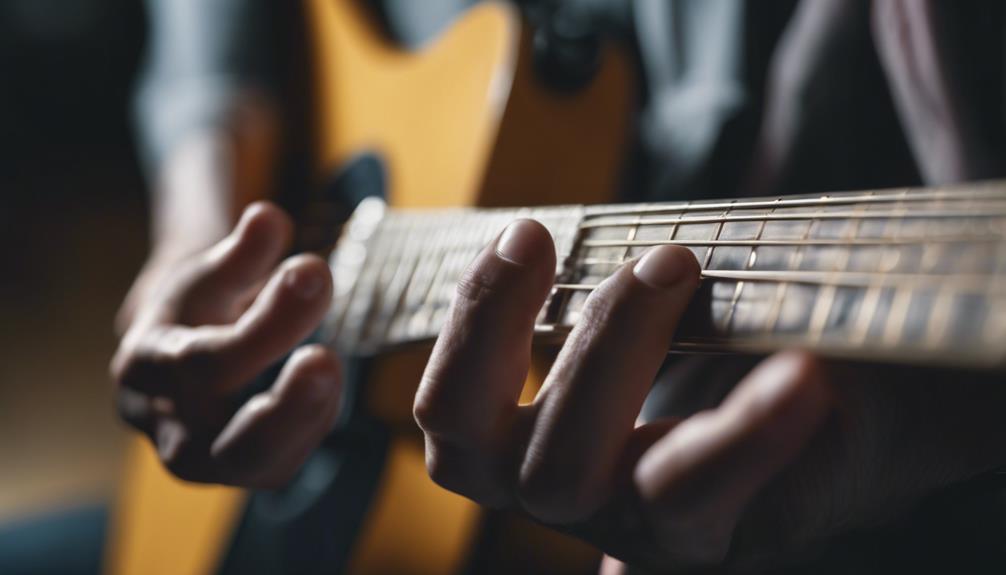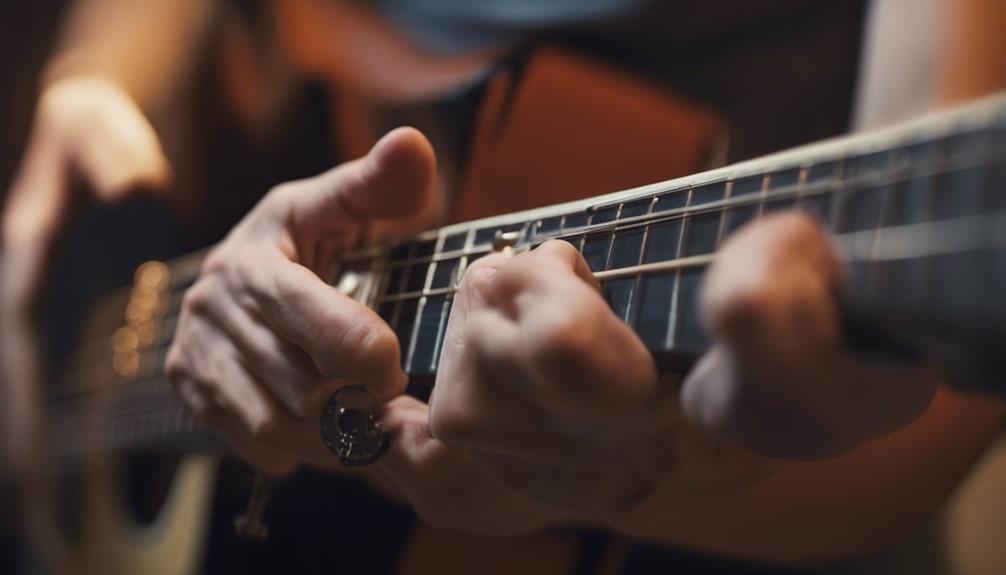You’ve likely heard that finger exercises and stretches are essential for any dedicated guitarist, but have you ever wondered why?
Incorporating these routines into your practice can enhance dexterity, agility, and strength, all while preventing injuries and fatigue. Imagine playing with ease, your fingers dancing effortlessly across the strings.
By focusing on finger, wrist, and thumb stretches, you’ll not only improve your hand coordination but also boost your overall comfort while playing.
Curious about the best techniques to incorporate into your routine? There’s more to uncover that could elevate your guitar playing to the next level.
TL-DR
- Regular finger stretching exercises improve hand flexibility, dexterity, and prevent injuries.
- Warm up with light activities like arm circles and jumping jacks to enhance blood flow and flexibility.
- Practice chromatic scales to develop finger independence, accuracy, and speed.
- Use the guitar neck for effective finger stretches, starting with easier positions and progressing to challenging ones.
- Take regular breaks and maintain proper technique to prevent overuse injuries and muscle strain.
Importance of Finger Exercises

Recognizing the significance of finger exercises can greatly improve your guitar performance by enhancing dexterity, agility, and strength. Finger stretching exercises play an essential role in this enhancement. By regularly incorporating these exercises, you warm up your hands, improving blood flow and flexibility. This is important for preventing injuries and reducing the risk of strain during playing.
When you make finger stretching exercises a part of your routine, you’re not just warming up; you’re also preparing your hands for more intricate movements. This preparation helps in executing complex guitar techniques with ease. It’s like giving your fingers a workout, building their endurance and resilience over time.
Moreover, these exercises are essential for guitarists at all levels. Whether you’re a beginner or a seasoned player, maintaining hand health is non-negotiable. Finger exercises ensure that your fingers remain nimble and responsive, allowing you to achieve your full playing potential. They help you navigate the fretboard smoothly, making shifts between chords and notes seamless.
Incorporating finger stretching exercises into your daily practice routine will enhance your overall playing ability and technique. You’ll find yourself playing more fluidly and effortlessly, opening up new levels of musical expression.
Benefits of Hand Stretches
Regular hand stretches offer numerous benefits that can greatly enhance your guitar-playing experience. By improving flexibility and reach, hand stretches allow you to comfortably play complex chords and scales. This increased range of motion makes switching between notes smoother, enhancing your overall performance quality.
Hand stretches are vital in preventing injuries. Guitar playing often leads to muscle tension and fatigue, but regular stretching alleviates these issues. You’ll find that your hands feel looser and more relaxed, reducing the risk of strains and overuse injuries. This is particularly important for those long practice sessions where maintaining hand health is essential.
Incorporating hand stretches into your routine also boosts circulation. Improved blood flow ensures that your muscles receive enough oxygen and nutrients, promoting quicker recovery and reducing soreness. Enhanced circulation contributes to better overall hand health, keeping your fingers nimble and responsive.
Developed at the concert conservatory for classical guitar, these hand stretching exercises show noticeable benefits within just a few days of consistent practice. Incorporating them into your daily routine guarantees that you’ll experience these advantages quickly.
Warm-Up Techniques

Before you start playing guitar, it’s essential to engage in proper warm-up techniques to make sure your body is ready. Begin with some light walking or jumping jacks to enhance blood flow and flexibility. This initial activity helps you get your blood pumping and prepares your muscles for more specific stretches.
Next, circle your arms and shoulders in small and large motions. These movements will warm up your upper body and stretch the muscles, ensuring they’re flexible and ready for action. Doing arm circles loosens up the shoulder joints and reduces the risk of strain.
Your wrists also need attention. Warm them up by doing figure eights, moving both clockwise and counterclockwise. This exercise helps to stretch the muscles in your wrists, preparing them for the intricate motions required when playing guitar. Keep your movements slow and smooth to avoid any sudden stress on your muscles.
Incorporating these full-body warm-ups, arm circles, and wrist exercises can notably improve your playing experience. By taking a few minutes to stretch the muscles and prepare your body, you’ll reduce the risk of injury and enhance your overall performance.
Basic Finger Stretches
After warming up your body, it’s time to focus on basic finger stretches to get your hands ready for playing the guitar. These stretches are essential for warming up and improving flexibility. They help prevent injuries, increase finger dexterity, and enhance overall performance.
Start with a simple stop gesture stretch. Extend your arm forward, palm facing out as if signaling someone to stop. Gently pull back your fingers with your other hand, feeling the stretch along your fingers and palm. Hold for 15-20 seconds, then switch hands.
Next, try the wrist bend stretch. Extend your arm forward, palm facing down. Use your other hand to gently push your fingers down, creating a stretch along the top of your forearm and wrist. Hold for 15-20 seconds and switch hands.
Spending a few minutes on these basic finger stretches can make a significant difference in your playing ability and comfort level. Incorporate these stretches into your practice routine regularly to see improvements in hand coordination and agility.
Wrist and Thumb Stretches

Incorporating wrist and thumb stretches into your routine helps prevent hand fatigue and injuries.
Focus on proper stretching techniques to enhance flexibility and ease tension.
These stretches will make your playing more comfortable and improve your dexterity over time.
Proper Stretching Techniques
Wrist stretches gently warm up the joints and boost flexibility, ensuring your hands are ready for playing guitar. Start by extending your arm out in front of you with your palm facing down. Use your other hand to gently pull your fingers back towards you, feeling a stretch along the underside of your wrist. Hold for about 15 seconds and then switch hands.
This simple movement helps prepare your wrists for the intricate motions required when playing guitar.
Next, focus on thumb stretches to enhance flexibility and mobility. Place your hand in front of you, palm facing up. With your other hand, gently pull your thumb back towards your wrist, holding the stretch for about 15 seconds. Repeat on the other thumb.
Proper thumb stretching techniques are essential for preventing injuries and ensuring your thumb joints remain flexible during guitar sessions.
Preventing Hand Fatigue
Consistently practicing wrist and thumb stretches can greatly reduce hand fatigue and enhance your guitar playing experience. When you play guitar, your wrist and thumb muscles work hard, often leading to strain and discomfort. By incorporating specific stretches, you can loosen up these muscles and increase flexibility in your wrist joint, making your practice sessions more comfortable and productive.
Wrist stretches are essential for preventing hand fatigue. They target the muscles and tendons that are heavily used while playing guitar, helping to prevent overuse injuries. A simple wrist stretch involves extending your arm with the palm facing down and gently pulling back on your fingers with your other hand. This stretch can improve wrist flexibility and reduce muscle tension.
Thumb stretches are equally important, as they enhance thumb mobility and reduce strain on the muscles used for gripping and fretting. To stretch your thumb, extend it away from your hand and use your other hand to gently pull it back. This will help improve endurance and comfort during long practice sessions.
Intermediate Finger Exercises
Now that you’ve mastered the basics, it’s time to tackle intermediate finger exercises like chromatic scale practice and string skipping. These exercises will push your finger strength and dexterity to new levels.
You’ll notice improved speed, accuracy, and control as you incorporate these into your practice routine.
Chromatic Scale Practice
Practicing the chromatic scale daily is crucial for improving finger dexterity and coordination on the guitar. The chromatic scale includes all twelve pitches in an octave, making it a thorough exercise for your fingers. By working through this scale, you’ll develop muscle memory and better fretboard navigation.
Start by playing the chromatic scale slowly. Focus on even spacing between your fingers and apply consistent pressure on the fretboard for a clean sound. Gradually increase your speed as you become more comfortable. This gradual approach guarantees that you’re not just playing fast but playing correctly.
Incorporating the chromatic scale into your daily routine can greatly enhance your overall playing technique. You’ll notice improvements in agility, precision, and the ability to move across different frets seamlessly. Remember, the key is to be consistent. Even a few minutes of dedicated practice each day can produce noticeable results over time.
Don’t rush the process. Pay attention to each note and ensure you’re hitting them accurately. This attention to detail will help you build a solid foundation for more complex techniques and faster playing. Mastering the chromatic scale is a stepping stone to becoming a more proficient guitarist.
String Skipping Exercises
String skipping exercises are essential for developing finger independence and accuracy by requiring you to skip over strings while playing. These exercises are vital for building finger strength and coordination, especially for intermediate players looking to enhance their overall guitar technique.
By practicing string skipping, you’ll enhance your ability to navigate the fretboard with precision.
To start, try a simple string skipping exercise. Use your index finger on the fifth fret of the low E string, then skip to the fourth fret of the D string with your middle finger. Continue this pattern, alternating between skipping strings and using different fingers. This not only engages your index finger but also challenges your other fingers to move independently and accurately.
Incorporate these exercises into your regular practice routine. You’ll notice that your finger dexterity and speed will improve significantly. As you get more comfortable, increase the tempo to further challenge your skills.
String skipping exercises are an excellent way to push your limits and refine your technique. Remember, consistency is key. Keep practicing, and you’ll see noticeable improvements in your playing skills over time.
Advanced Finger Techniques

Mastering advanced finger techniques on the guitar requires precise coordination and control to navigate challenging musical passages with ease. These techniques are essential for executing intricate movements up and down the guitar neck, allowing you to play complex phrases smoothly and confidently. To achieve this, you’ll focus on improving your finger placement, speed, and overall dexterity.
Practicing advanced finger exercises regularly will help you tackle difficult pieces. Start with scales and arpeggios, which are fundamental for building speed and accuracy. Incorporate challenging chord progressions to enhance your ability to shift quickly between chords. Here are some key benefits:
- Improved Finger Dexterity: Advanced exercises develop finger strength and independence, important for playing faster and more accurately.
- Smoother Movements: Practicing complex movements ensures seamless shifts between notes and chords, making your playing sound more fluid.
- Increased Confidence: Mastering these techniques boosts your confidence, making it easier to approach and perform challenging musical passages.
Consistent practice is key. Dedicate time each day to work on these exercises, and you’ll notice significant improvements in your playing. Remember, the goal is to play with precision and confidence, making even the most demanding pieces feel effortless.
Using a Guitar for Stretching
Leverage the guitar neck as an anchor point to perform effective finger stretches that boost flexibility and reach. Start by placing your fingers on the 7th fret, where the stretch is less intense and easier to manage. Gradually, you can move down the neck to more challenging positions.
Focus on creating gaps between each finger, which will enhance your hand’s coordination and help you play more complex chords and melodies.
Incorporating these finger stretches into your daily practice routine is essential. Not only will this improve your finger dexterity, but it will also increase agility, allowing you to navigate the fretboard with ease.
Use simple exercises, like spreading your fingers apart while pressing down on different frets. This helps build the necessary hand and finger strength for comfortable playing.
Common Mistakes to Avoid

When practicing guitar finger exercises and stretches, it’s important not to overuse your non-dominant hand as it can lead to muscle fatigue.
Always incorporate a warm-up routine to prepare your fingers and avoid injuries.
Remember to take rest periods to let your hands recover and prevent strain.
Overusing Non-Dominant Hand
Overusing your non-dominant hand while playing guitar can lead to muscle imbalances and strain, ultimately hindering your progress. Many guitarists, especially beginners, tend to overwork their left hand by focusing solely on fretting. This can cause unnecessary tension and limit your overall skill development. Instead, aim for a balanced approach that includes both hands equally.
To maintain dexterity and control, it’s important to distribute your playing evenly between your left hand and right hand. This not only prevents injury but also ensures that both hands develop strength and coordination together.
Here are some key points to keep in mind:
- Balanced Practice: Make sure you’re not favoring one hand over the other. Practice exercises that require equal participation from both hands.
- Proper Technique: Use correct hand positioning and movements to reduce strain. Avoid gripping the neck too tightly with your left hand.
- Rest and Recovery: Give your muscles time to recover. Overuse can lead to fatigue and long-term injuries.
Ignoring Warm-Up Routine
Neglecting a proper warm-up routine can be as crucial as overusing your non-dominant hand, leading to muscle strain and slower progress. When you skip warming up, you’re putting yourself at risk for reduced flexibility and increased injury. This can severely impact your playing ability, making it harder to execute complex chords and solos.
You need to stretch before diving into your practice sessions. Ignoring this essential step can result in decreased finger dexterity and agility, ultimately affecting your overall performance quality. Without proper warm-ups, your muscle memory and coordination suffer, making it more challenging to master new techniques and challenging songs.
Skipping Rest Periods
Skipping rest periods during your practice sessions can jeopardize your progress and increase the risk of injury. When you push through without taking regular breaks, fatigue sets in, leading to decreased performance and a higher chance of muscle strain. This is especially important for your ring finger, which often carries significant tension during complex chords and stretches.
Regular breaks are essential to maintaining excellent hand flexibility and preventing overuse injuries. If you ignore rest periods, your muscles won’t have the necessary time to recover, and you’ll likely see a plateau in your skill development.
Consider the following points:
- Muscle Recovery: Adequate rest allows your muscles, particularly in your hands and fingers, to recover and adapt, leading to better long-term results.
- Preventing Strain: Regular breaks help prevent muscle strain, ensuring that your ring finger and other digits remain flexible and responsive.
- Sustained Growth: Incorporating planned rest periods into your practice routine is crucial for sustained growth and overall improvement as a guitarist.
Breathing Techniques
Mastering proper breathing techniques is essential for staying relaxed and enhancing your guitar performance. When you monitor your body’s rigidity and focus on avoiding tension through proper breathing, you’ll notice a significant improvement in how you play.
Shallow breaths can lead to unnecessary tension and discomfort, while deep, mindful breaths help keep your body loose and your mind at ease.
Being aware of your breathing patterns is critical. Start by taking deep, slow breaths and notice how it affects your grip on the guitar and the fluidity of your movements. This awareness can transform your playing experience, making it more enjoyable and less strenuous.
A relaxed mindset, achieved through these breathing techniques, can dramatically improve your abilities, enabling smoother shifts and better control.
For those looking to explore further, the book ‘Effortless Mastery’ by Kenny Werner offers valuable insights into the role of breathing in musical performance. Werner emphasizes the importance of breath for achieving a state of relaxation and peak performance.
Preventing Overuse Injuries

To prevent overuse injuries while playing the guitar, it’s important to practice proper technique and take regular breaks. Overuse injuries can lead to conditions like tendonitis, carpal tunnel syndrome, and repetitive strain injury.
Paying attention to your technique, especially when pressing down on the low E string, can make a significant difference in preventing these issues. Start by maintaining good posture. Sit or stand with a straight back, keeping your shoulders relaxed. This helps distribute the strain evenly across your body. Use ergonomic equipment, such as a comfortable chair or a guitar strap that supports your instrument properly.
Listening to your body’s signals is essential. If you feel pain, stiffness, or tingling in your hands, wrists, or arms, stop playing immediately and rest. These are early signs that you might be overdoing it. Ignoring these signals can lead to more severe injuries.
Incorporate these practices into your routine:
- Stretch regularly: Stretch your fingers, hands, and wrists before and after playing.
- Strengthen muscles: Use exercises to strengthen the muscles in your hands and arms.
- Adjust technique: Make sure you’re not pressing too hard on the strings, especially the low E string.
Rest and Recovery Tips
After preventing overuse injuries with proper technique, it’s vital to focus on effective rest and recovery strategies. Taking regular breaks during practice sessions helps prevent both fatigue and overuse injuries. During these breaks, engage in light physical activities like walking or stretching. These actions promote blood circulation, which is indispensable for muscle recovery.
Plan your practice sessions efficiently to avoid excessive strain on your fingers and hands. This means structuring your time to include periods of intense focus followed by moments of rest. Such planning helps you maintain a balance, ensuring you don’t overwork your muscles.
Incorporate post-playing stretches for your shoulder muscles to prevent tension and tightness. Stretching your shoulders can alleviate the stress accumulated during practice, aiding in overall muscle relaxation. If you experience persistent pain or discomfort in your fingers, wrists, or hands, seek professional help immediately. Ignoring these symptoms can lead to more severe injuries.
Let me know if you have any questions about these rest and recovery tips. Proper rest and recovery not only enhance your playing experience but also guarantee that you can continue to enjoy your guitar practice without enduring unnecessary pain or injury.
Incorporating Exercises Into Practice

Incorporating finger exercises into your daily guitar practice enhances finger flexibility and agility, establishing a strong foundation for improved performance.
Start with gentle warm-up movements like slow finger rolls and wrist circles. These help prepare your hands for more targeted stretches.
Once warmed up, utilize the guitar neck to focus on creating gaps between your fingers and improving coordination between both hands.
To guarantee thorough finger development, mix in exercises without the guitar. These will maintain finger independence and flexibility.
Remember, it’s not just about the exercises, but how you integrate them into your routine.
Here are some tips:
- Consistency: Dedicate a specific time during your practice session for these exercises.
- Variety: Rotate different exercises to target various aspects of flexibility and strength.
- Breaks: Take regular breaks and use breathing techniques to stay relaxed and avoid tension.
Next up, learn how to play lead guitar in this guide.
